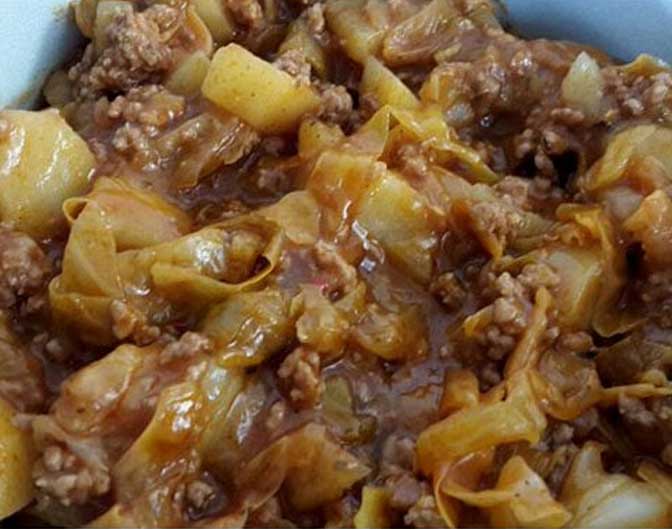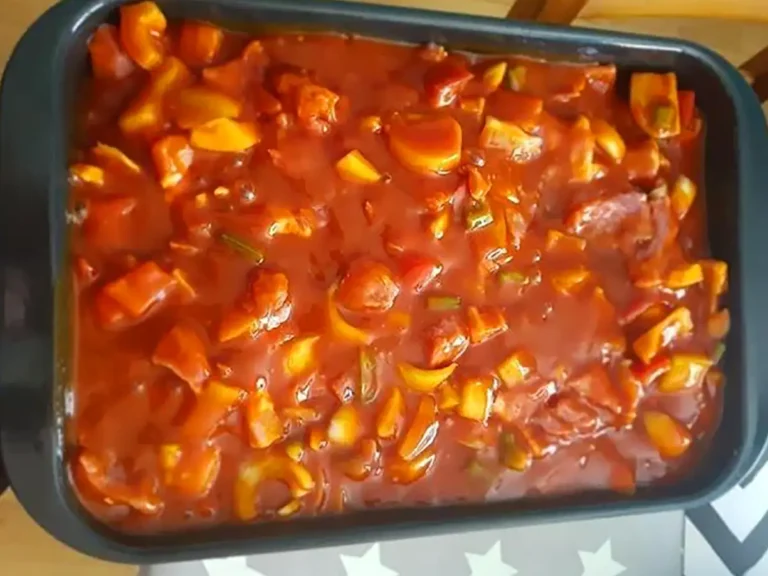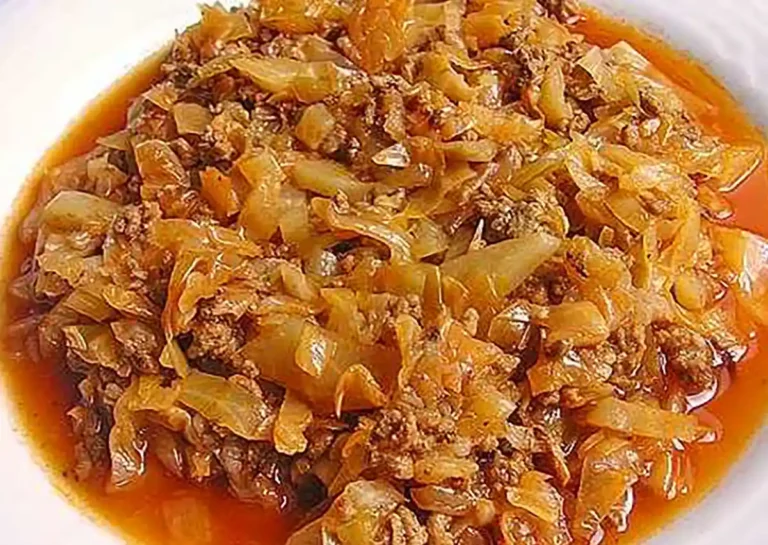Schichtkohl oder Schmorkohl mit Salzkartoffeln Rezept

Schichtkohl Rezept: Hausmannskost, die satt und glücklich macht
Wer nach einem schichtkohl rezept sucht, will meistens ein bodenständiges, herzhaftes Gericht auf den Tisch bringen – am liebsten wie früher bei Oma. Genau das kenne ich nur zu gut! Schichtkohl war eines der ersten Rezepte, die ich als junger Mensch selbst ausprobiert habe. Damals ging natürlich viel schief (zu viel Wasser, Fleisch verklumpt, der Kohl war matschig). Aber heute? Ist es mein absolutes Lieblingsessen, wenn es draußen kühl und ungemütlich wird. Ein echtes Wohlfühlessen, das satt macht und sich wunderbar vorbereiten lässt – auch für Gäste oder die Familie.
Warum lieben wir eigentlich solche Klassiker wie schichtkohl mit hackfleisch oder schmorkohl rezept? Weil sie einfach sind, keine komplizierten Zutaten brauchen und immer gelingen – naja, meistens. Ich verrate dir heute mein ganz persönliches Rezept, erzähle von meinen Fehlern und gebe Tipps, damit dein Schichtkohl perfekt wird. Und ich verspreche: Du brauchst keine Kochschule, nur Lust auf deftige Hausmannskost!
Tradition trifft Alltag: Was macht Schichtkohl so besonders?
Schichtkohl ist ein einfacher Eintopf, eigentlich. Aber was da am Ende im Topf landet, ist viel mehr als die Summe seiner Teile. Die Kombination aus zartem Weißkohl, würzigem Hackfleisch und ein bisschen Zwiebel schmeckt einfach immer. Und: Es ist ein Gericht, das auch am zweiten Tag noch besser wird – falls überhaupt etwas übrig bleibt. Früher wurde Schichtkohl oft in großen Mengen für die ganze Familie gekocht und dann mit salzkartoffeln serviert. Genau so mache ich es heute noch.
Das Schöne: Die Zutaten bekommt man überall und sie sind nicht teuer. Gerade in der kalten Jahreszeit ist Schichtkohl ein echter Sattmacher. Und, Hand aufs Herz: Wer kann bei so einem Duft schon widerstehen?
Schichtkohl Rezept: Zutatenliste für das perfekte Ergebnis
Bevor wir loslegen: Die Zutaten sind heilig und werden genauso verwendet, wie sie sind – keine Änderungen, kein Schnickschnack. So schmeckt Schichtkohl richtig authentisch!
- 1 ½ kg Weißkohl (white cabbage)
- 1 kg Hackfleisch (ground meat, typically beef or mixed)
- 1 medium-sized onion
- Some margarine
- Salt
- Pepper
- Water
- Instant broth (or bouillon cubes)
- Optional: caraway seeds (Kümmel), whole or ground
Zubereitung:
- Begin by preparing the vegetables. Remove any damaged outer leaves from the white cabbage. Cut the cabbage into quarters, remove the core, and then slice the quarters into small pieces or thin strips. Peel the onion and dice it finely.
- Heat a large roasting pan or Dutch oven over medium-high heat and add a generous amount of margarine. Once the margarine has melted and is hot, add a portion of the cabbage. Avoid overcrowding the pan; it is better to fry the cabbage in batches so that it browns nicely rather than steams. Stir occasionally until the cabbage begins to soften and develop some golden color. Transfer the browned cabbage to a large bowl and repeat with the remaining cabbage until all of it is browned.
- Once all the cabbage has been sautéed, return it to the pan. Add the diced onions and fry together with the cabbage for a few minutes until the onions become translucent and fragrant.
- Meanwhile, heat a large skillet over high heat and add a little margarine. Add the ground meat and break it up with a spatula. Fry the meat thoroughly, stirring often, until it is nicely browned and cooked through. Season the meat generously with salt and pepper while frying.
- Add the browned ground meat to the cabbage and onion mixture in the roaster or Dutch oven. Mix everything well so that the ingredients are evenly distributed.
- Pour in about 1 to 1.5 liters of water, enough to cover the mixture partially but not to submerge it. Add instant broth or bouillon cubes according to package instructions, adjusting the amount to your taste so that the dish is well-seasoned but not too salty. Stir well to combine.
- If you enjoy the flavor of caraway, add a small amount of whole or ground caraway seeds to the pot. This helps with digestion and adds a traditional flavor. If you do not like caraway, you can omit it.
- Bring the mixture to a gentle simmer over medium heat. Cover with a lid and let it cook for about 30 to 40 minutes, stirring occasionally, until the cabbage is tender and the flavors have melded together. If too much liquid evaporates, add a bit more water as needed. Taste and adjust the seasoning with additional salt and pepper as desired.
- While the cabbage and meat mixture is simmering, peel and cut potatoes into even-sized pieces for boiling. Place the potatoes in a large pot, cover with cold water, and add a generous pinch of salt. Bring to a boil, then reduce the heat and simmer for about 20 minutes or until the potatoes are cooked through and fork-tender. Drain the potatoes when done.
- Once the cabbage and meat mixture is ready and the potatoes are cooked, serve the Schichtkohl (layered or braised cabbage) hot alongside the boiled potatoes. Optionally, garnish with fresh herbs or a sprinkle of additional pepper.
Tipps aus meiner Küche: So gelingt einfaches Schichtkohl Rezept immer
Ich weiß noch, wie ich beim ersten Mal viel zu viel Wasser genommen hab – das Ergebnis war eher eine Kohlsuppe! Also wirklich nur so viel zugeben, dass alles ein bisschen bedeckt ist, aber nicht schwimmt. Und immer wieder umrühren, damit nix anbrennt. Ein weiteres Missgeschick: Ich hab das Hackfleisch früher einfach roh reingeschichtet. Nein, bloß nicht! Erst schön anbraten, das gibt Röstaromen und macht den Geschmack viel besser. Glaub mir, das macht den Unterschied!
Magst du es lieber kräftig? Dann ruhig ordentlich Pfeffer und vielleicht einen Hauch Kümmel dazu. Schichtkohl mit salzkartoffeln ist für mich Pflicht – die Kartoffeln saugen die Soße auf, das ist einfach lecker. Und falls du mal zu viel gemacht hast: Am nächsten Tag schmeckt’s fast noch besser, weil alles schön durchgezogen ist.
Familienessen, das verbindet: Warum Schichtkohl immer geht
Was mich am schichtkohl rezept begeistert? Es ist ehrlich, sättigend, unkompliziert und bringt alle an einen Tisch. Für mich gibt es kaum ein besseres Gericht, wenn ich Besuch bekomme oder meine Kinder nach Hause kommen. Jeder nimmt sich, was er mag, und es bleibt nie etwas übrig. (Und falls doch – ab in den Kühlschrank, am nächsten Tag kurz aufwärmen, fertig.)
Du siehst: Ein einfaches schichtkohl rezept braucht keine Tricks, nur ein bisschen Geduld und Lust auf gutes Essen. Also, ran an den Topf, lass dich auf den Duft ein und genieße ein Stück Kindheitserinnerung. Hast du’s schon mal ausprobiert? Oder hast du vielleicht sogar noch einen Tipp, wie es bei euch zu Hause gemacht wird? Lass es mich wissen – ich freu mich auf deine Erfahrungen und wünsche guten Appetit!
Tipps & Tricks rund ums Schmorkohl Rezept: So gelingt der deutsche Kohleintopf immer!
Warum wird mein Schichtkohl manchmal zu wässrig – was mache ich falsch?
Das ist mir auch schon passiert! Meistens liegt es daran, dass zu viel Wasser hinzugefügt wurde oder der Deckel während des Schmoren zu fest saß. Versuche, am Anfang weniger Wasser zu nehmen – du kannst immer noch nachgießen, falls es zu trocken wird. Und wenn doch mal zu viel Flüssigkeit im Topf ist: Einfach etwas länger offen köcheln lassen, dann verdampft das überschüssige Wasser.
Kann ich beim Schichtkohl Rezept das Hackfleisch ersetzen?
Na klar – ich hab’s schon mit vegetarischem Hack probiert und das klappt super! Auch gemischtes Hack oder nur Rind geht. Wer es deftiger mag, kann etwas durchwachsenen Speck oder Mett dazugeben. Für eine vegane Variante einfach pflanzliches Hack und vielleicht ein paar Linsen untermischen.
Wie kann ich Schmorkohl am besten aufbewahren oder einfrieren?
Schmorkohl lässt sich richtig gut vorbereiten! Im Kühlschrank hält er sich locker 2-3 Tage, einfach in einem luftdichten Behälter lagern. Zum Einfrieren fülle ich ihn gerne portionsweise in Dosen – hält sich dann etwa 2-3 Monate. Beim Auftauen lasse ich ihn über Nacht im Kühlschrank und wärme ihn langsam auf (schmeckt oft sogar noch besser, finde ich!).
Welche Beilagen passen noch zu Schichtkohl mit Salzkartoffeln?
Salzkartoffeln sind der Klassiker, aber ich serviere manchmal auch frisches Bauernbrot dazu – das saugt die Soße wunderbar auf! Wer’s etwas feiner mag, probiert ein Kartoffelpüree. Ein Klecks Senf oder eine Prise frischer Schnittlauch machen sich auch super als Topping.
Ist Schichtkohl eigentlich auch für Gäste oder besondere Anlässe geeignet?
Unbedingt! Gerade weil man ihn gut vorbereiten kann, ist Schichtkohl perfekt für Familienfeiern oder wenn Besuch kommt. Ich bereite ihn oft am Vortag zu – dann zieht er schön durch. Aufgewärmt schmeckt er sogar fast noch besser, ehrlich!


Schichtkohl oder Schmorkohl mit Salzkartoffeln Rezept
- Total Time: 30
- Yield: 3 Portionen 1x
Description
Zart geschmorter Weißkohl und würziges Hackfleisch verschmelzen in aromatischer Brühe. Goldgelbe Salzkartoffeln begleiten das saftige, leicht karamellisierte Kohlgericht – herzhaft, sämig und unwiderstehlich duftend.
Ingredients
- 1 ½ kg Weißkohl (white cabbage)
- 1 kg Hackfleisch (ground meat, typically mixed pork and beef)
- 1 medium onion
- Margarine (for frying)
- Salt
- Pepper
- Water
- Instant broth or bouillon cubes
- Caraway seeds (Kümmel), optional
Instructions
- Prepare the cabbage by removing any damaged outer leaves. Cut the white cabbage into small pieces or thin strips using a sharp knife. Set aside.
- Peel the onion and dice it into small, even pieces.
- Heat a generous amount of margarine in a large roasting pan or Dutch oven over medium-high heat. Add the cabbage in batches to avoid overcrowding the pan. Sauté each batch until the cabbage begins to brown and reduce in volume, stirring occasionally to prevent sticking. Once each batch is lightly browned, transfer it to a bowl and continue with the next batch until all cabbage is cooked.
- After all the cabbage is browned, return it to the roasting pan. Add the diced onions and sauté together with the cabbage for a few more minutes until the onions become translucent and fragrant.
- In a separate large skillet or frying pan, heat a small amount of margarine over high heat. Add the ground meat and break it up with a spatula or wooden spoon. Fry the meat until it is well browned and no longer pink, making sure to crumble it into small pieces. Season generously with salt and pepper during cooking.
- Once the ground meat is browned, add it to the cabbage and onion mixture in the roasting pan. Stir thoroughly to combine all ingredients evenly.
- Pour in approximately 1 to 1.5 liters of water, just enough to mostly cover the cabbage and meat mixture. Add instant broth or bouillon cubes according to package instructions for the amount of water used, stirring to dissolve and distribute the flavor. Taste and adjust the seasoning with more salt and pepper if necessary.
- If desired, add caraway seeds or ground caraway to the pan. Caraway helps with digestion and adds a distinctive, aromatic flavor to the dish. Stir well to incorporate.
- Cover the roasting pan with a lid and let the mixture simmer gently over low to medium heat for 45-60 minutes. Stir occasionally, ensuring nothing sticks to the bottom, until the cabbage is tender and the flavors are fully developed. Add more water if needed to prevent the mixture from drying out.
- While the cabbage and meat mixture simmers, prepare salted potatoes (Salzkartoffeln) as a traditional side dish. Peel and quarter the potatoes, place them in a pot of salted water, bring to a boil, and cook until tender, about 20 minutes. Drain before serving.
- Once the Schichtkohl is ready and the cabbage is soft, taste one final time and adjust seasoning if needed. Serve the cabbage and meat stew hot alongside the salted potatoes, or enjoy it on its own as a hearty one-pot meal.
Notes
Schichtkohl, also known as Schmorkohl, is a classic German comfort food that tastes even better when reheated the next day. For extra flavor, you can add a bay leaf or a bit of smoked paprika to the pot. Caraway is optional but highly recommended for its distinct taste and digestive properties. If you prefer, you can use oil or butter instead of margarine. This dish can easily be prepared in advance and reheated, making it perfect for meal prep or family gatherings.
- Prep Time: 10
- Cook Time: 20
- Category: Schnelle und Einfache Rezepte
Nutrition
- Serving Size: 3 Portionen
- Calories: 300-400
- Sugar: 3-8g
- Sodium: 500-800mg
- Fat: 12-20g
- Saturated Fat: 4-8g
- Carbohydrates: 40-50g
- Fiber: 2-5g
- Protein: 20-30g
- Cholesterol: 60-100mg






